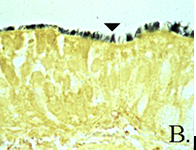Etiology: Filobacterium rodentiumis a Gram-negative filamentous rod that moves by gliding motility. This organism can induce a chronic pulmonary disease syndrome. Filobacterium rodentium usually occurs concomitantly with Mycoplasma pulmonis infection.
Incidence: Although the incidence of infection is rare, the significance when present is high, often leading to fulminating respiratory disease.
Transmission: Transmission by direct contact with infected secretions has been reported. In breeding populations, neonates can acquire the organism from the dam within a week after birth [1].
Clinical Signs: Subclinical infections are possible. Infection begins without clinical signs. Adverse environmental factors, such as high cage ammonia levels, and/or the acquisition of primary viral or bacterial respiratory pathogens activate subclinical infections. Early signs of overt disease include an oculonasal discharge and torticollis. As the organisms travel down the respiratory tract, labored breathing, anorexia, and hunched posture occur. Other clinical signs include snuffling, chattering, anorexia with weight loss, rough hair coat, hunched posture, and reduced fertility.

Pathology: In the upper respiratory tract, a purulent discharge may be found on the nasal mucosa and within the tympanic bullae. This purulent exudate can be found in the trachea and bronchi causing yellow parenchymous foci which may progress to form bullae (bronchiectasis) and red to grey areas of consolidation. Histological examination of lungs reveals a purulent bronchopneumonia with moderate hyperplasia of the normally rare peribronchial lymphoid aggregates. Examination of silver-stained respiratory sections will help identify the presence of Filobacterium rodentium, which will stain with silver and are present among the cilia of the airways (arrowhead, B.).
Diagnosis: MFI and IFA are commercially available for serological screening for Filobacterium rodentium infections in mouse colonies. PCR assays on nasal or tracheal samples are also used for diagnosis.
1. The Mouse In Biomedical Research. 2 ed. American College of Laboratory Animal Medicine. Vol. 2. 2007, 30 Corporate Drive, Suite 400, Burlington, MA 01803: Elsevier.